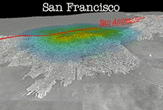Watch Earth Rock and Roll in New Simulation of 1906 Quake

The 1906 San Francisco earthquake was so powerful and pervasive that it damaged buildings in Ferndale, a small town 200 miles to the north in Humboldt County. It was felt in Los Angeles, 400 miles to the south.
Other quakes have been much more intense, but few have had such reach.
Now geologists have done a high-powered computer simulation that shows how hard and long the ground shook as waves of Earth propagated from the epicenter.
As the 100th anniversary of the event approaches—April 18—the geologists want to remind people of the risks associated with the next Big One.
"We want to emphasize that a large earthquake such as 1906 is not just a San Francisco quake, but a Northern California earthquake," said Brad Aagaard, geophysicist at the U.S. Geological Survey who led the effort. "Earthquakes greater than magnitude 7 are going to cause intense shaking over a large area — everyone needs to be prepared."
Earthquakes send out seismic waves that are akin to sound waves. They move somewhat like ripples on a pond but with many complex variations related to changes in the density of material through which they travel.
The 1906 quake killed more than 3,000 people. Damage exceeded $400 million, much of it due to fires. But the shaking was incredible.
Sign up for the Live Science daily newsletter now
Get the world’s most fascinating discoveries delivered straight to your inbox.
"For the new fault rupture model, we re-analyzed century-old surveying and seismographic data," said Seok Goo Song, a geophysics graduate student at Stanford University. "Our model confirms the rupture was about 300 miles long with a magnitude of 7.8-7.9. Our work gives new insights into the strength of strong ground shaking in large earthquakes."
The scientists did a similar recreation of the deadly 1989 magnitude-6.9 Loma Prieta earthquake. That event did not influence such a broad region.
"It´s not that the ground motions in 1906 were significantly larger than those in 1989—it´s that the area experiencing intense shaking was much, much greater," Aagaard said. "We don´t know if the next rupture will look like 1906 earthquake, but we know that many of the same areas hit hard in 1906, like San Francisco, Santa Rosa, and the Santa Cruz mountains will be hit hard again in the next large earthquake on the San Andreas Fault."
Geologists generally agree that something like 1906 is likely to happen again. The Bay Area has a 1 percent chance of a magnitude-7 or greater earthquake every year and a 25 percent chance that one will occur within two decades, according to the most recent estimates.
Building codes have been improved over the years, but many older buildings still are not prepared to withstand a major temblor.
"When the 1906 event reoccurs, we´d expect tremendous damage to structures around the Bay Area," said Rich Eisner, regional director of the Office of Emergency Services. "We need to rebuild now to reduce our vulnerability before an earthquake hits."
Robert is an independent health and science journalist and writer based in Phoenix, Arizona. He is a former editor-in-chief of Live Science with over 20 years of experience as a reporter and editor. He has worked on websites such as Space.com and Tom's Guide, and is a contributor on Medium, covering how we age and how to optimize the mind and body through time. He has a journalism degree from Humboldt State University in California.










